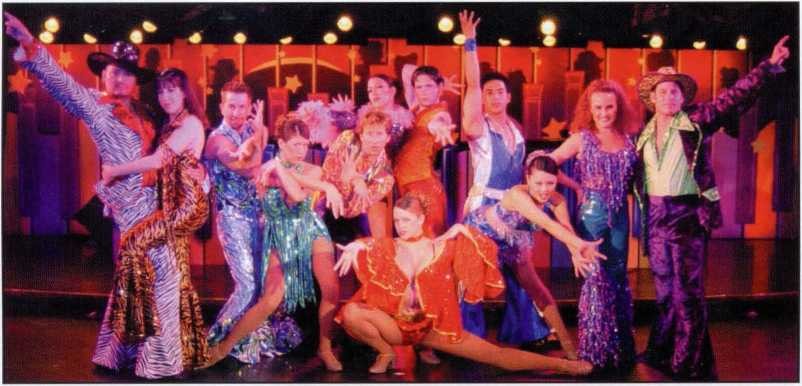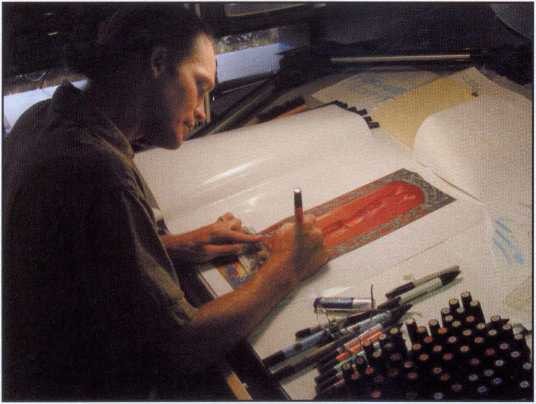When passengers walk into the cavernous space that is different and nicer than many Broadway theaters, they think it’s an incredible theater,” said Brian O’Keeffe, manager of global entertainment at Paramount Entertainment Services, describing the theaters on Royal Caribbean International’s (RCI) Voyager-class ships. The Voyager theaters and similar venues on other cruise vessels represent major advances in state-of-the- art entertainment.
 “Cruise ship architects have become very savvy to what is needed by entertainment departments to produce shows of the magnitude cruise lines now expect,” explained Doug Jones, president of Sixth Star Entertainment and Marketing. And impressive as the new theaters are, they are just one venue in the expanding hi-tech entertainment packages designed to foster a cruise ship’s image as a true vacation destination.
“Cruise ship architects have become very savvy to what is needed by entertainment departments to produce shows of the magnitude cruise lines now expect,” explained Doug Jones, president of Sixth Star Entertainment and Marketing. And impressive as the new theaters are, they are just one venue in the expanding hi-tech entertainment packages designed to foster a cruise ship’s image as a true vacation destination.
Entertainment venue expansion is providing new challenges and opportunities for the cruise industry’s suppliers of entertainment systems, stage productions and performers. One is to maintain the uniqueness between the ships and cruise lines with special touches and variations tailored to compliment corporate philosophies, marketing factors, ship size and itinerary. Also playing a role is selecting the right mix of entertainment for each ship considering the number and frequency of repeat passengers and vessel itineraries. Jones explained that lines such as Radisson Seven Seas Cruises, Crystal Cruises and Seabourn Cruise Line typically change theater shows more often “because they are smaller fleets with more repeat passengers, while on Carnival Cruise Lines they keep shows on longer.” Passenger expectations now demand that lounge and theater entertainment should be more than just keeping half of the passengers occupied while the others have dinner.
Rigidly fixed entertainment schedules also do not work well on Norwegian Cruise Line’s (NCL) Lreestyle Cruising ships, where passengers have been given greater discretion regarding when and where to enjoy cruise ship amenities. One recent answer by NCL was to commission Paramount Show Services International to install a new three-show program on the Norwegian Sea. It provides Lreestyle cruise passengers “with something going on in many different places all day long,” according to Paramount Executive Producer John Ancona.
“Lights Down. Curtains Up!” is a phrase that has signaled the start of theater shows for generations, including those at sea. According to Jones, the new approaches to expanded shipboard entertainment venues require, in effect, that curtains are going up all over the ship at different times of the day – every day. Entertainment is steadily spilling out of the theaters, and at the same time, it is also becoming increasingly interactive. O’Keeffe cited two examples on Voyager ships: Passengers can go skating with the performers after the ice-show performance is over, while the parades down the middle of the promenade most nights enliven the interactive entertainment atmosphere throughout the ship. On Princess ships, the aft pool area has become another entertainment venue by moving more entertainment outside under the stars. Robert Koval, CEO of Thomas Gregor Associates, said it is moving performers out of just performing in lounges and theaters. “In the past, there might have been a roving band out on the deck but now you’ll have a larger band or small orchestra set up out there at night.” Passenger demographics continue to be a major driving force in selecting the best entertainment offerings based on a ship’s features and cruise itinerary. Passengers are becoming younger, often cruising as families; so many entertainment itineraries are tailored to them. More technically sophisticated teen centers and rock-wall climbing are designed to target younger age groups. At show time in the theaters and lounges, “You have to come up with new twists. Not just theater reviews but really edgy shows with outrageous costuming and in-your-face music that is edgy and pop and speaks to the younger generations,” said Ancona. “Times change and they don’t just want the 30’s and 40’s. They do enjoy the contemporary programming too,” he noted.
Behind The Scenes
For the entertainers and show producers, the lines’ investments in large new theaters have created new opportunities. Lines have given up cabin space to provide vertical space in the three- to five- deck-high theaters for fly gallery systems, automated scenery, stage lifts and turntables. Paramount’s O’Keeffe said the size and equipment of the new ships’ theaters “make them better than most Broadway theaters and better than 85 percent of the Las Vegas theaters. As a point of reference, a recent Voyager-class ship, while docked in Turku, Finland, was actually the second largest theater in the whole country – rivaled only by Helsinki’s Opera House.”
 The large shipboard theaters have their learning curves. Directors have long experience working in lounges, but a massive moving theater is different. The new fly galleries have been calculated for certain weights but Koval cautioned that consideration must be given to the fact that “over a period of three or four months, there will obviously be some movements up there – how will that affect the equipment? It requires balancing out how much they can put in the air, the elevators and the lifts.”
The large shipboard theaters have their learning curves. Directors have long experience working in lounges, but a massive moving theater is different. The new fly galleries have been calculated for certain weights but Koval cautioned that consideration must be given to the fact that “over a period of three or four months, there will obviously be some movements up there – how will that affect the equipment? It requires balancing out how much they can put in the air, the elevators and the lifts.”
The hi-tech electronics, lighting and sound systems are generally the same as those specified for landside entertainment venues with a few significant engineering exceptions. “On a ship the equipment being mounted is not taking the shear but moving in every conceivable way the ship can move,” said Koval. Aboard a ship, vibration in varying intensities is an almost constant reality and mechanical shock conditions from heavy seas are not uncommon. Thomas Gregor’s component specifications for their vendors provide for those and other conditions, said Koval. Ex-amples are redesigned speaker mounting brackets to be more robust and equipment racks with powder coat finishes to resist the salt air on-deck installations. “The outdoor decks are probably the most difficult applications we face,” he noted.
The electrical power sources, especially on a new ship, present other challenges for equipment suppliers. It is vital to ensure entertainment system components are properly designed and grounded. According to Christian Hugener, chief technical officer at Thomas Gregor, “Off-the-shelf filters can cause ground problems” and the entertainment system’s equipment must also be designed not to affect the ship’s electrical system grounding, “which they try to keep very clean because of the electrolysis,” he noted.
Entertainment system reliability and ease of operation are also key design goals so that shipboard personnel can operate and maintain the equipment. “We keep the user interface simple and easy to operate, but what’s behind the interface is very technologically advanced,” Hugener explained. If a problem occurs, comprehensive guidelines to solve it are available because, he noted, “the last thing you should do is have so much computer- based technology and then not have a clear, easy-to-use troubleshooting path.” Under development at Thomas Gregor is a landside support system that will allow access via the Internet into shipboard entertainment systems by landside techies to trouble-shoot and remedy possible problems.
Trends and Opportunities
The newer cruise ships are being built with more state-of- the-art facilities, enhanced entertainment capabilities and technical sophistication rivaling the best landside entertainment venues. Shows are no longer little musical revues with three male and three female performers but have grown to as many as 30 performers. Cruise lines are steadily improving Internet capa-bilities for passengers from the cafes to individual staterooms. Other venues for the entertainment systems are becoming more sophisticated, including the ability to call up different audio channels in such areas as the health centers and even massage rooms, noted Koval. An area of potential cruise ship revenue, use of facilities for business meetings or conventions, may be emerging slowly, but Koval said cruise line investments have been made and Thomas Gregor crews have already equipped some vessels “so entertainment venues can double as meeting rooms. In the meantime, many of the ship business centers are maxing out at capacity.”
Another growing opportunity: upgrading older, smaller ships to the rapidly advancing entertainment venue standards. Demographics are always a consideration. Some of the older, ships have a loyal, repeat passenger following, whose demographics may be a key issue in deciding how much new investment is advisable to provide the new “sizzle” on the entertainment side. Costs are always a factor in planning the timing and scope of the improvements. Thomas Gregor is currently reviewing entertainment systems on several older ships and preparing proposals to bring them up toward current standards by upgrading existing hardware and systems. “The old technology is good equipment but not necessarily suitable for features such as providing Internet access in each cabin,” said Koval. A challenge for significant entertainment system upgrades is installing the needed new wiring while the ships are at sea. “We are talking about a lot of fiber-optic cable,” he noted. Final equipment installations would then be completed during the short shipyard refit periods.
Across the board, the cruise industry is ready to again expand the onboard entertainment venues using the advancing technologies and expanded shipboard facilities. Opportunities, said Jones, “will come down to taking the space you have and doing the most with it.” The trends, especially on the larger ships, will continue to center on theaters and lounges as the big draw, but the entertainment on all ships will spill beyond those walls to the entire vessel. O’Keeffe believes the bottom line is simply that “today people want something new happening all the time.” Stan Morrell, executive director at Paramount Parks Global Entertainment Services, said, “Passengers on cruise ships, whether large or small, will increasingly expect a synergism of entertainment venues, challenging the cruise lines to meet or exceed those expectations on a variety of levels every day.” And for the suppliers, those challenges represent continuing opportunities.



